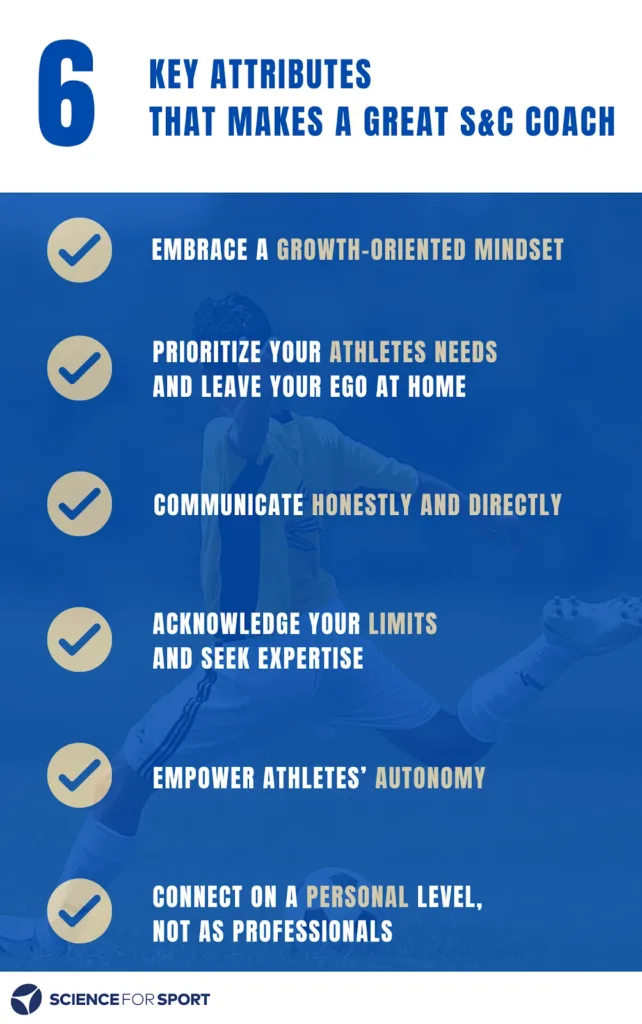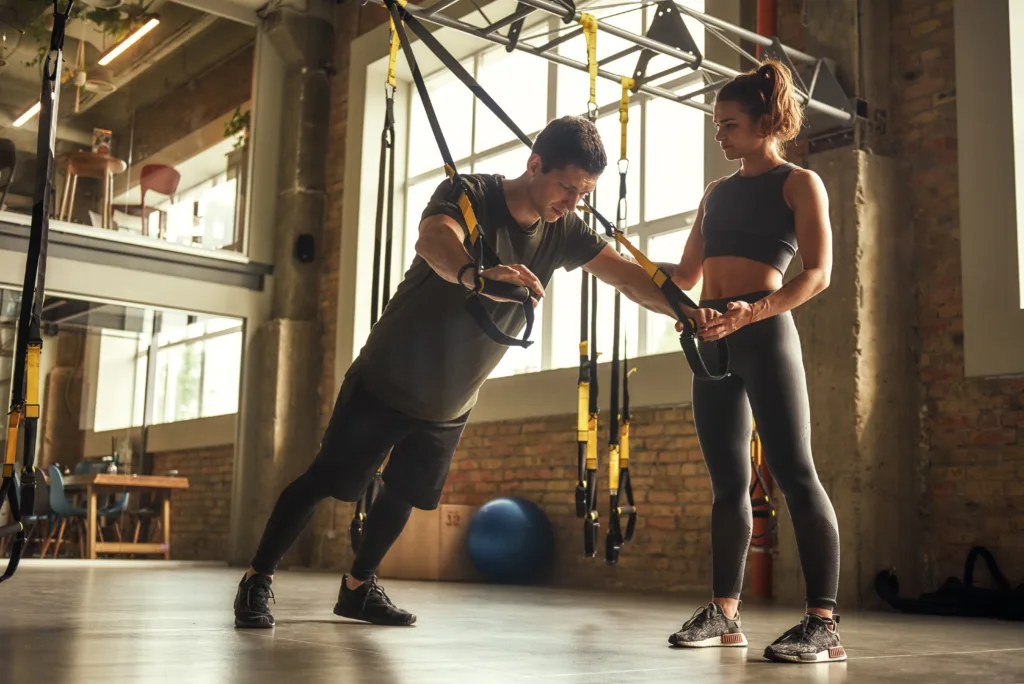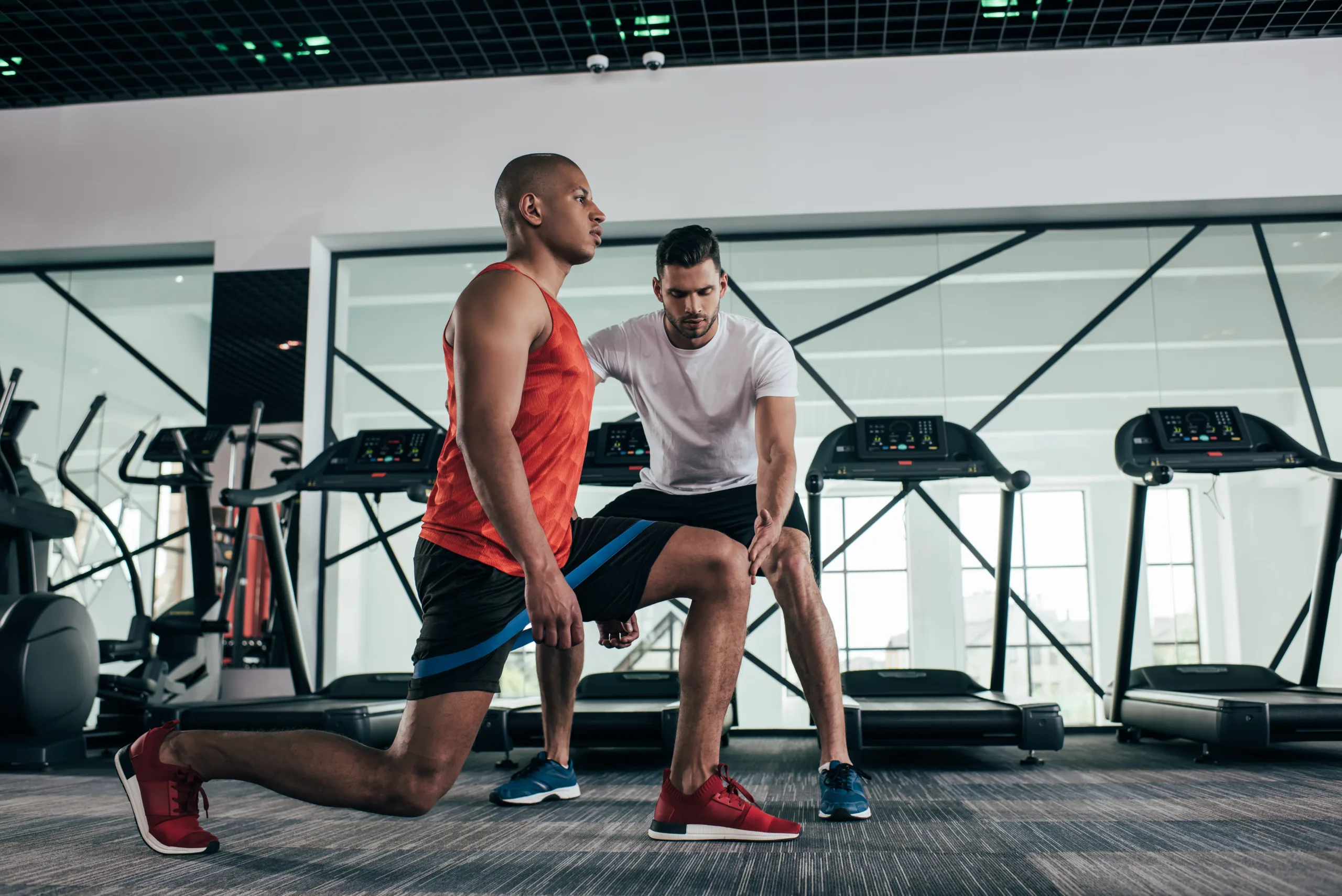Contents
- Introduction
- Embrace a Growth-Oriented Mindset
- Prioritize your athletes’ needs and leave your ego at home
- Communicate Honestly and Directly
- Acknowledge Limits and Seek Expertise
- Empower Athletes’ Autonomy
- Connect on a Personal Level, not just as professionals
Introduction
Strength and Conditioning (S&C) coaches hold a key role in enhancing athletes’ performance and minimising injury risks during sports participation. Knowledge of training principles, exercise physiology, anatomy, biomechanics, and the ability to design precise training programs for optimal performance are all key abilities for an S&C coach to have. However, an often-overlooked aspect is understanding human motivation, effective communication, and the right approach to guide individuals toward self-improvement. Neglecting these factors can present barriers in the coach´s strive to develop high-performing athletes.
To become a highly skilled and sought-after S&C coach, it is advisable to explore the fields of behavioural psychology and leadership. This article outlines 6 key attributes that will make you as a new S&C coach better prepared to coach athletes. Let’s explore the 6 key attributes that every S&C coach should strive to develop.

Embrace a growth-oriented mindset
Mindset as an S&C coach should be a top priority when considering personal development. When discussing the impact of mindset on one’s career, the work of Carol Dweck is a key reference tool. In her book “Mindset: The New Psychology of Success,” Dweck differentiates two distinct types of mindsets: the “Fixed mindset” and the “Growth mindset.” Individuals with a fixed mindset tend to believe that talent is inherited, while those with a growth mindset believe that persistence and hard work can make a coach develop and that it is possible to learn or improve in almost any skill. Choice of mindset significantly affects the approach to work and response to criticism or setbacks (2).
So, how does all this apply to S&C coaches? Those with a fixed mindset tend to focus too much on talent, and when they realise that they lack talent, they may either waive any thoughts about possible personal shortcomings or give up and quit. Does this sound like the path to becoming a top-level coach? Certainly not. To excel as an S&C coach, it is strongly recommended to adopt a growth mindset. As Dweck explains in her book “Mindset: Changing The Way You Think To Fulfill Your Potential,” individuals with a growth mindset value constructive feedback, welcome challenges, and bounce back stronger after any defeat or failure (2).
For example, if a newly qualified coach gets the opportunity to spend an hour with a highly experienced S&C coach who has worked many years with elite international clubs, how well that hour is utilised will depend on their mindset. A fixed mindset might lead the new coach to avoid asking questions that they think might be stupid and reveal gaps in their knowledge. In contrast, a growth mindset would encourage the new coach to enjoy the opportunity, ask questions, and attempt to add golden nuggets to their existing knowledge. A growth-mindset would also be willing to change from his or her existing beliefs if those were to be proven false, and instead adopt a new way to think in line with what seems to be the right information at the time.
Prioritise your athletes’ needs and leave your ego at home
Ego has no place in coaching. It’s key to always prioritize what’s best for your athletes to facilitate their improvement. While this may seem obvious in theory, it can be challenging. Transitioning from playing sports to coaching requires a change in mindset. As a player, the focus is to become a better player, with less focus on the needs of others. However, it is important to understand that as a coach, the primary task is to provide athletes with the best training suited for their needs; most athletes only care that the exercises programmed will help them elevate their performance within their sport.

Communicate honestly and directly
Honesty and straightforward communication are highly valued qualities, not only in the business world but also among athletes. Research by Perry and Mankin (2007) indicates that work satisfaction and trust in leaders are closely related to their leader’s level of honesty and ability to communicate fairly and directly (3). As an S&C coach, athletes very much appreciate honesty and clear communication between them and their coaches and executives. The level of honesty can be seen in a variety of situations, from club executives making promises about the direction of a club or future resources to coaches explaining reasons behind player selections.
It is also essential to address an athlete’s physical weaknesses or areas for improvement. Honesty and straightforward communication apply to our profession as well. But it is how well this information is packaged and delivered to the athletes that is the real deal breaker. While being direct in communication is important, the tone and how the message is framed are equally critical. Giving constructive feedback shows that the athlete’s best interests are the priority, and this could be a springboard to a more productive working environment.
Acknowledge limits and seek expertise
When athletes come to a coach for help on a topic that lies beyond their area of expertise, it’s important that the coach admits that they lack the requested knowledge and instead helps them find someone with more knowledge in that area; happily sharing weaknesses with the athletes will build credibility and trust. The next time the same athlete approaches a coach for help, they will assume that they are exactly the right person to ask because they will have built trust with that coach to guide them to the right source for that information. Instead of pretending to know everything, it is important to say, “I don’t know, but I can find out,” or “This topic falls outside my expertise; perhaps you should consult…” and follow up, demonstrating integrity and honesty, further building trust.
Empower athletes’ autonomy
According to self-determination theory (SDT), autonomy is an essential psychological need that contributes to enhanced intrinsic motivation and psychological health (1). In order to increase athletes’ autonomy, provide them with choices within the prescribed training programs that are still aligned with the goals strived to achieve.
One concrete example is the following: The day’s focus is lower-body strength, and the athletes are told:
“Today, you can choose between Trap bar deadlifts and High bar back squats.. Giving athletes a choice shows them that their opinion is important, and invites collaboration in their development. So, when using this approach, the program does not only target the key physical capacities but also targets increased intrinsic motivation, which is very important for their long-term commitment to the program.
As a coach, it is possible to take this collaborative approach to programming to a different level; invite the athletes to share which skills or physical capabilities they want to develop. After identifying areas of improvement (that both coach and athlete agree on), start to give them different exercise options that all share the same fundamental training principles and aim. This is a much more motivating way to work for all parties, as a motivated and happy athlete is a more successful athlete. So next time, invite the athletes to create a programme together, improving commitment to development and developing intrinsic motivation.
Connect on a Personal Level, not just as professionals
Relatedness, another key component of SDT, represents the human need to feel part of a community where people care for and look out for each other (1). At the beginning of a coaching career, athletes are often considered purely through their performances. If that is the case it is important to change perspective. Senior coaches may say something like: “Don’t get too caught up in their personal lives. You are their coach, not their friend”. While this is true to some extent, by getting to know athletes on a personal level and by understanding their drive and appreciating them as people, coaching becomes easier and much more fun. Also, when motivation is running low as a coach, or when there is a bad day at work, considering athletes as people and not as professionals can help to readjust one’s mindset. Treating them as people first and athletes second should be a guiding principle in any coaching career.
For more ways to level up your coaching, listen to the following podcast hosted by Matt Solomon with Scott Caulfield, Director Of Strength & Conditioning at Colorado College.
- Deci, E. L., & Ryan, R. M. (2000). The ‘what’ and ‘why’ of goal pursuits: Human needs and the self-determination of behaviour. Psychological Inquiry, 11(4): 227-268. [Link]
- Dweck, C. (2009). Mindset: The New Psychology of Success. Random House Publishing Group: New York.
- Perry, R. W., & Mankin, L. D. (2007). ‘Organizational Trust, Trust in the Chief Executive, and Work Satisfaction’. Public Personnel Management, 36(2): 165–179. doi.org/10.1177/009102600703600205. [Link]



